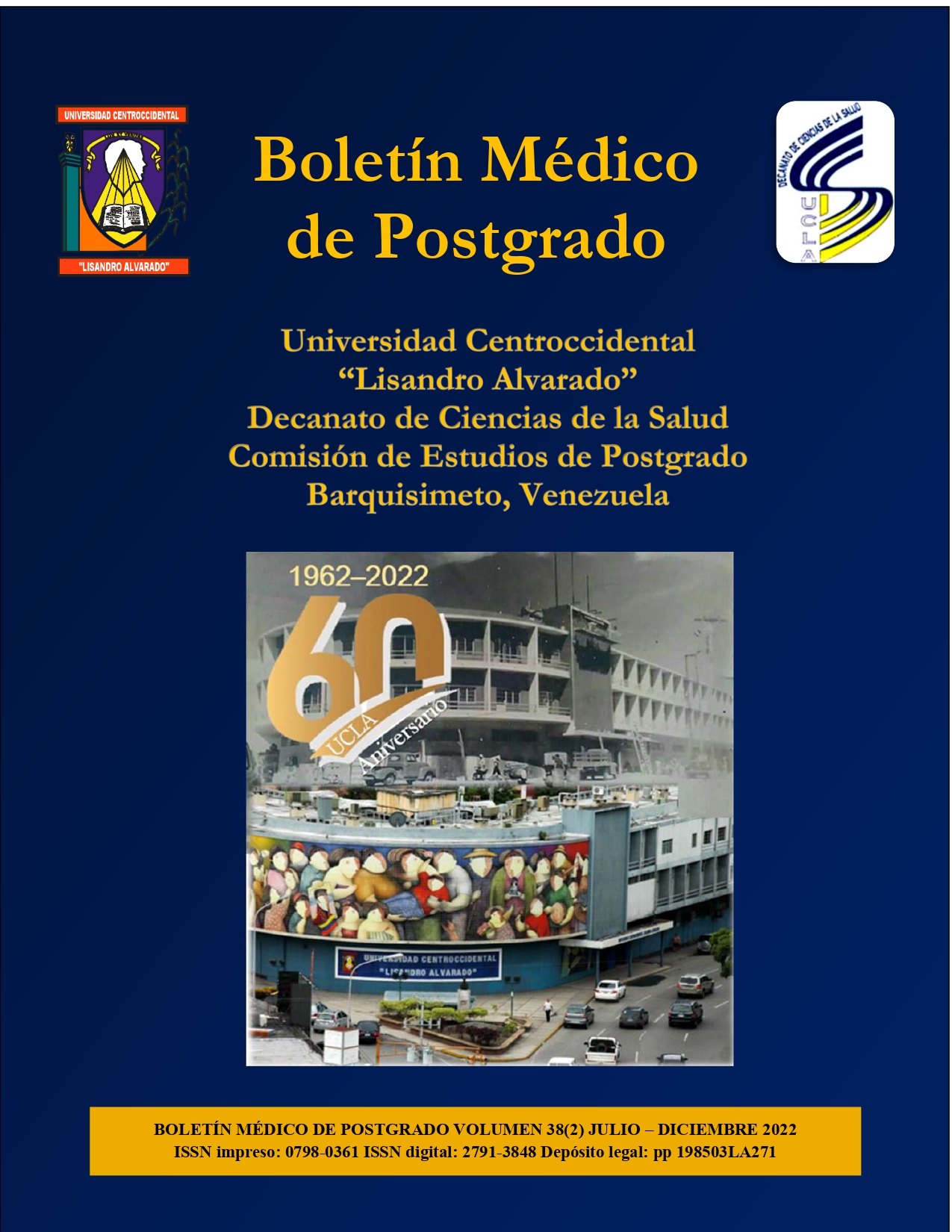Clinical and paraclinical characteristics of cerebral salt wasting syndrome in patients with vascular cerebral disease Hospital Central Universitario Dr. Antonio María Pineda
Keywords:
cerebral hemorrhage, brain ischemia, hyponatremia, sodium, osmolar concentrationAbstract
With the aim of describing the clinical and paraclinical characteristics of brain salt wasting syndrome (SCPS) in patients with cerebral vascular disease (CVD) who were admitted to the Internal Medicine Department of the Dr. Antonio María Pineda Central University Hospital during the period April-July 2020, a cross-sectional descriptive study was conducted with a sample of 29 patients who were characterized by an average age of 61.55 ± 12.92 years with a predominance of male sex (55.17%). 65.52% of the patients presented hemorrhagic and 34.48% ischemic CVD, with an average evolution time of 2.45 ± 1.81 days. Improvement was observed in the mean values of serum sodium, plasma osmolarity, urinary osmolarity and urinary sodium, between admission, day 3, 7 and 10 (p < 0.05) in contrast to glycemia whose variations were not significant (p = 0.17). 57.89% of the patients with hemorrhagic CVD presented moderate hyponatremia and in 60% of the patients with ischemic CVD the hyponatremia was severe. The clinical evolution was favorable in 73.68% of patients with hemorrhagic CVD and 50% with ischemic CVD. Sodium alterations can negatively affect the neurological evolution of patients with CVE, increasing hospital stay and mortality rate. These results provide real and updated information on the frequency of SCPS in patients with CVE in our hospital.
Downloads
References
Esnaola M, Gregori L. (2015). Protocolo de manejo inicial del ataque Cerebrovascular (ACV) Isquémico Agudo. Ministerio de Salud de la Nación. Programa Nacional de Prevención y Control de Enfermedades Cardiovasculares. República Argentina.
Ferri C, Schoenborn C, Kalra L, Acosta D, Guerra M, Huang Y, et al. Prevalence of stroke and related burden among older people living in Latin America, India and China. J Neurol Neurosurg Psychiatry 2016; 82(10): 1074-82.
Ministerio del Poder Popular para la Salud. (2018). Anuario de Mortalidad 2014. Dirección General de Epidemiología. Gaceta Oficial de la República Bolivariana de Venezuela Nº 41.426.
Kunst E, Amiri M, Janssen F. The decline in stroke mortality. Stroke 2011; 42: 2126-2130.
Gonzáles R, Landínez, D. Epidemiología, etiología y clasificación de la enfermedad vascular cerebral. Universidad de Manizales. Caldas, Colombia. Archivos de Medicina (Col) 2016; 16(2): 495-507.
Sanoja A. (2015). Relación del Sodio Plasmático con la evolución neurológica en pacientes con Enfermedad Cerebrovascular Hemorrágica. Trabajo Especial de Grado para optar al título de Especialista en Medicina Interna. Universidad de Carabobo. Maracay, Venezuela.
Bayona H, Schroeder N. (2011). Alteraciones hidroelectroliticas y enfermedad cerebrovascular. Capítulo 12. Guía Neurológica 8. Enfermedad Cerebrovascular.
Leonard J, Garrett R, Salottolo K, Slone D, Mains C, Carrick M, et al. Pérdida de sal cerebral después de una lesión cerebral traumática: una revisión de la literatura. Scand J Trauma Resusc Emerg Med 2015; 23: 98.
Pradhan B, Majhi C, Panigrahi S. Clinical profiles, electrolytes status in acute strokes and their outcome. Int J Adv Med 2018; 5: 492-7.
Panda M, Kumari P, Kumar M, Kumar A, Soumya S. Altered Serum Electrolyte Status in Acute Stroke Patients in Western Odisha, A Predictor of Syndrome of Inappropriate ADH (SIADH) or Cerebral Salt Wasting Syndrome (CSWS). J Clin Diag Res 2019; 13(1): BC10-BC13.
Hankey J. Potential new risk factors for ischemic stroke. What is their potential? Stroke 2006; 37: 2181-2188.
Montaner J, Álvarez J. La escala de ictus del National Institute of Health (NIHSS) y su adaptación al español. Neurología 2006; 1: 192-202.
Kembuan M. Electrolyte Disturbances among Acute Stroke Patients in Manado, Indonesia. Global Journal of Medicine and Public Health 2014; 3(1).
Roy K., Bandyopadhyay R., Paul R., Chakraborty S, Ray D, Mitra S, et al. Study on serum and urinary electrolyte changes in cerebrovascular accident. J Indian Acad Clin Med 2014; 15(2):91-95.
Ehtesham M, Mohmand M, Raj K, Hussain T, Kavita F, Kumar B. Clinical Spectrum of Hyponatremia in Patients with Stroke. Cureus 2019; 11(8): e5310.
Lakshmi S, Rani D. Study of Serum Sodium Levels in Acute Ischemic Stroke Patients in Tertiary Care Hospital. J App Med Sci 2019; 7(11): 3597-3601.
Merino, T. (2019). Disnatremias en pacientes con Lesión Cerebral Aguda Severa en la Unidad de Cuidados Intensivos del Hospital Luis Vernaza Durante el periodo mayo 2017-mayo 2018. Trabajo de titulación presentado como requisito previo a Optar al grado académico de Especialista en Medicina Crítica. Universidad de Especialidades Espíritu Santo. Samborondón, Guayaquil, Ecuador.
Santiago, A. (2016). Síndrome cerebral perdedor de sal en el paciente neurocrítico: epidemiología, clínica y tratamiento. Tesis para optar al Posgrado de Especialización en Clínica Médica de la Facultad de Ciencias Médicas Universidad Nacional de Rosario. Santa Fe, Argentina.
Manzanaresa W, Aramendia I, Langloisb P, Biestroa A. Hiponatremias en el paciente neurocrítico: enfoque terapéutico basado en la evidencia actual. Med Intensiva 2015; 39(4): 234-243.
Mahesar S, Memon S, Mustafa S, Javed A, Butt S. Evaluation of Hyponatremia in Ischemic Stroke Patients in a Tertiary Care Hospital of Karachi, Pakistan. Cureus 2019; 11(1): e3926.
Published
How to Cite
Issue
Section

This work is licensed under a Creative Commons Attribution-NonCommercial-ShareAlike 4.0 International License.
Las opiniones expresadas por los autores no necesariamente reflejan la postura del editor de la publicación ni de la UCLA. Se autoriza la reproducción total o parcial de los textos aquí publicados, siempre y cuando se cite la fuente completa y la dirección electrónica de esta revista. Los autores(as) tienen el derecho de utilizar sus artículos para cualquier propósito siempre y cuando se realice sin fines de lucro. Los autores(as) pueden publicar en internet o cualquier otro medio la versión final aprobada de su trabajo, luego que esta ha sido publicada en esta revista.



